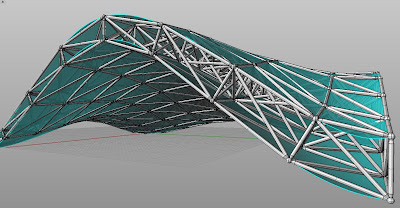
Here's a solution for generating spaceframes from two surfaces. Struts and joints are real reactive components. As mentioned before, surfaces are first segmented by quad-mesh-faces, from which i derive lists of respective vertices. Since this is done for two surfaces, corresponding points on both of them can easily be connected with struts. For these, an additional script component had to be added, since there's no way i know of that can get me groupwise lofts from one large list of profiles. (And even if there was one, a tiny script definitely is the cleaner way, at least until david will come up with more advanced ways of dealing with data-streams).

Due to the topology of meshes, i get lots of redundant surfaces, which, because of their opposing orientation, can't be detected automatically. Also, some unecessary cross-wise struts show up. These issues could be addressed by skipping a strut where there is already another differently oriented one, which on the other hand leads to missing parts at the structure-boundaries. However, i might take care of that later.
http://rapidshare.com/files/205363664/spaceframe02.zip

















